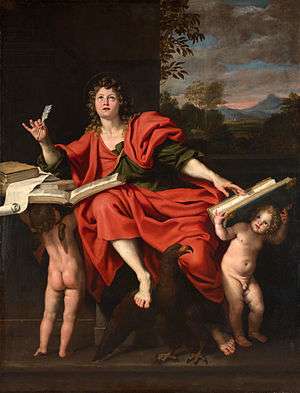Signs Gospel
| Part of a series of articles on |
| John in the Bible |
|---|
 |
| Johannine literature |
| Authorship |
| Related literature |
| See also |

The Signs Gospel or the semeia source is a hypothetical gospel account of the life of Jesus Christ which some scholars have suggested could have been a primary source document for the Gospel of John. This theory has its basis in source criticism. Since the commentary of Rudolf Bultmann was published in 1941,[1] the hypothesis of a semeia (sign or miracle) source has gained some acceptance.[2]
Internal evidence
One possible construction of the "internal evidence" states that the Beloved Disciple wrote an account of the life of Jesus. However, this disciple died unexpectedly, necessitating that a revised gospel be written. In other words, it may be that John “is the source" of the Johannine tradition but "not the final writer of the tradition." [3] Therefore, scholars are no longer looking for the identity of a single writer but for numerous authors whose authorship has been absorbed into the gospel's development over a period of time and in several stages.[4][5][6]
Bultmann
The hypothesis of the Gospel of John being composed in layers over a period of time originated in the work of Rudolf Bultmann in 1941. Bultmann suggested that the author(s) of John depended in part on an author who wrote an earlier account.[7] This hypothetical "Signs Gospel" listing Christ's miracles was independent of, and not used by, the synoptic gospels. It was believed to have been circulating before the year 70 AD. Bultmann's conclusion was so controversial that heresy proceedings were instituted against him and his writings.
Later scholarship
Nevertheless, this hypothesis has not disappeared. Scholars such as Raymond E. Brown believe that the original author of the Signs Gospel to be the Beloved Disciple. They argue that the disciple who formed this community was both a historical person and a companion of Jesus Christ. Brown also suggests that the Beloved Disciple had been a follower of John the Baptist before joining Jesus.[8]
It is now widely agreed that the Gospel of John draws upon a tradition of Miracles of Jesus which is substantially independent of the three synoptic gospels.[9]
Jesus Seminar
The Jesus Seminar has detected at least two distinct writing styles contained in the Gospel of John. The later style contains midrash and theological essays placed in the mouth of Jesus. The other - earlier - style is the original Signs Gospel, possibly written by the "Beloved Disciple". It is simple, direct and historical in style and can be reconstructed as follows:
- John the Baptist (1:6-7,19-49)
- Water into wine (2:1-11)
- Official's son healed (2:12a,4:46b-54)
- Catch of 153 fish (21:1-14)
- Feeding 5000 (6:1-14)
- Walking on water (6:15-25)
- Raising of Lazarus (11:1-45)
- Blind man given sight (9:1-8)
- Healing at the Pool of Bethesda (5:2-9)
- Plot to kill Jesus (11:47-53)
- Temple incident (2:14-19)
- Jewish rejection (12:37-40)
- Mary anoints Jesus (12:1-8)
- Entering Jerusalem (12:12-15)
- Arrest (18:1-11)
- Before the High Priest (18:12-27)
- Before Pilate (18:28-19:16a)
- Crucifixion (19:16b-37)
- Joseph of Arimathea (19:38-42)
- Empty tomb (20:1-10)
- Do not hold on to me (20:11-18)
- Great Commission (20:19-22)
- Conclusion (20:30-31ab)
References
- ↑ Das Evangelium des Johannes (1941), translated as The Gospel of John: A Commentary, Westminster ,John Knox Press, 1971, ISBN 0-664-20893-2
- ↑ D. Moody Smith (1976), "The Setting and Shape of a Johannine Narrative Source", in Journal of Bibilical Literature, Vol. 95, No. 2 (June 1976), pp. 231-241: "Once it is granted that John's miracle tradition is not based upon the Synoptics, a miracle source (or a source that included miracles) becomes a reasonable hypothesis", accessed 6 February 2016
- ↑ Paul N. Anderson, John, Jesus, and History: Critical Appraisals of Critical Views, Volume 1, Symposium series, no. 44, Society of Biblical Literature Pub, 2007 p.78
- ↑ Raymond Edward Brown, The Community of the Beloved Disciple, Paulist Press, 1979 pp.31 - 34
- ↑ The Muratorian fragment dates from around 180 It states that while John was the primary author, several people were involved, that mutual revision was part of the original intent of the authors, and that the editors included the apostle Andrew. (Geza Vermes, The authentic gospel of Jesus, London, Penguin Books. 2004. A note on sources, p. x-xvii.
- ↑ Paul N. Anderson, John, Jesus, and History: Critical Appraisals of Critical Views, Volume 1, Symposium series, no. 44, Society of Biblical Literature Pub, 2007 p.77
- ↑ Frank E. Peters "How to Proceed" The Quest: The Historians' Quest for the Historical Jesus and Muhammad, Modern Scholar 2008.
- ↑ Raymond Edward Brown, The Community of the Beloved Disciple, Paulist Press, 1979 pp.31 - 34
- ↑ D. Moody Smith (1976), "The Setting and Shape of a Johannine Narrative Source", in Journal of Bibilical Literature, Vol. 95, No. 2 (June 1976), pp. 231-241: "Although the evidence is not entirely unambiguous and scholarly opinion is not unanimous, the trend of much recent work is against John's dependence upon the Synoptics", accessed 6 February 2016